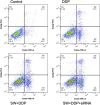Low-energy shock waves promote the cisplatin chemosensitivity of human osteosarcoma MNNG/HOS cells via the P2X7/Akt/mTOR pathway
- PMID: 38694312
- PMCID: PMC11060266
- DOI: 10.1097/MS9.0000000000001909
Low-energy shock waves promote the cisplatin chemosensitivity of human osteosarcoma MNNG/HOS cells via the P2X7/Akt/mTOR pathway
Abstract
Background: The current dilemma of osteosarcoma treatment is the resistance of chemotherapeutic drugs after long-term usage, which also introduces life-threatening side effects.
Methods and results: To minimize chemoresistance in osteosarcoma patients, the authors applied shock waves (SWs) to human osteosarcoma MNNG/HOS cells, then evaluated the cell viability and extracellular ATP levels, and further investigated the effect of SWs on cisplatin (DDP) cytotoxicity in MNNG/HOS cells. The authors' results showed that 400 SW pulses at 0.21 mJ/mm2 exhibited little influence on the MNNG/HOS cell viability. In addition, this SW condition significantly promoted the extracellular ATP release in MNNG/HOS cells. Importantly, low-energy SWs obviously increased Akt and mammalian target of rapamycin (mTOR) phosphorylation and activation in MNNG/HOS cells, which could be partially reversed in the presence of P2X7 siRNA. The authors also found that low-energy SWs strongly increased the DDP sensitivity of MNNG/HOS cells in the absence of P2X7.
Conclusions: For the first time, the authors found that SW therapy reduced the DDP resistance of MNNG/HOS osteosarcoma cells when the ATP receptor P2X7 was downregulated. SW therapy may provide a novel treatment strategy for chemoresistant human osteosarcoma.
Keywords: DDP; P2X7; human osteosarcoma; shock wave.
Copyright © 2024 The Author(s). Published by Wolters Kluwer Health, Inc.
Conflict of interest statement
The authors declare that they have no conflicts of interest.Sponsorships or competing interests that may be relevant to content are disclosed at the end of this article.
Figures




Similar articles
-
Highly-expressed P2X7 receptor promotes growth and metastasis of human HOS/MNNG osteosarcoma cells via PI3K/Akt/GSK3β/β-catenin and mTOR/HIF1α/VEGF signaling.Int J Cancer. 2019 Aug 15;145(4):1068-1082. doi: 10.1002/ijc.32207. Epub 2019 Mar 18. Int J Cancer. 2019. PMID: 30761524 Free PMC article.
-
Reversion effects of curcumin on multidrug resistance of MNNG/HOS human osteosarcoma cells in vitro and in vivo through regulation of P-glycoprotein.Chin Med J (Engl). 2013 Nov;126(21):4116-23. Chin Med J (Engl). 2013. PMID: 24229684
-
The inhibition of MARK2 suppresses cisplatin resistance of osteosarcoma stem cells by regulating DNA damage and repair.J Bone Oncol. 2020 Apr 19;23:100290. doi: 10.1016/j.jbo.2020.100290. eCollection 2020 Aug. J Bone Oncol. 2020. PMID: 32368441 Free PMC article.
-
Anti-osteoblastogenic, pro-inflammatory and pro-angiogenic effect of extracellular vesicles isolated from the human osteosarcoma cell line MNNG/HOS.Bone. 2021 Dec;153:116130. doi: 10.1016/j.bone.2021.116130. Epub 2021 Jul 28. Bone. 2021. PMID: 34329816
-
LncRNA NORAD targets miR-410-3p to regulate drug resistance sensitivity of osteosarcoma.Cell Mol Biol (Noisy-le-grand). 2020 Jun 5;66(3):143-148. Cell Mol Biol (Noisy-le-grand). 2020. PMID: 32538761
References
-
- Bramer JA, van Linge JH, Grimer RJ, et al. . Prognostic factors in localized extremity osteosarcoma: a systematic review. Eur J Surg Oncol 2009;35:1030–1036. - PubMed
-
- Yamamoto N, Tsuchiya H. Chemotherapy for osteosarcoma - where does it come from? What is it? Where is it going? Expert Opin Pharmacother 2013;14:2183–2193. - PubMed
-
- Palmero A, Berger M, Venturi C, et al. . High energy shock waves enhance the cytotoxic effect of doxorubicin and methotrexate to human osteosarcoma cell lines. Oncol Rep 2006;15:267–273. - PubMed
-
- Lopez-Marin LM, Rivera AL, Fernandez F, et al. . Shock wave-induced permeabilization of mammalian cells. Phys Life Rev 2018;26-27:1–38. - PubMed
LinkOut - more resources
Full Text Sources
Miscellaneous
